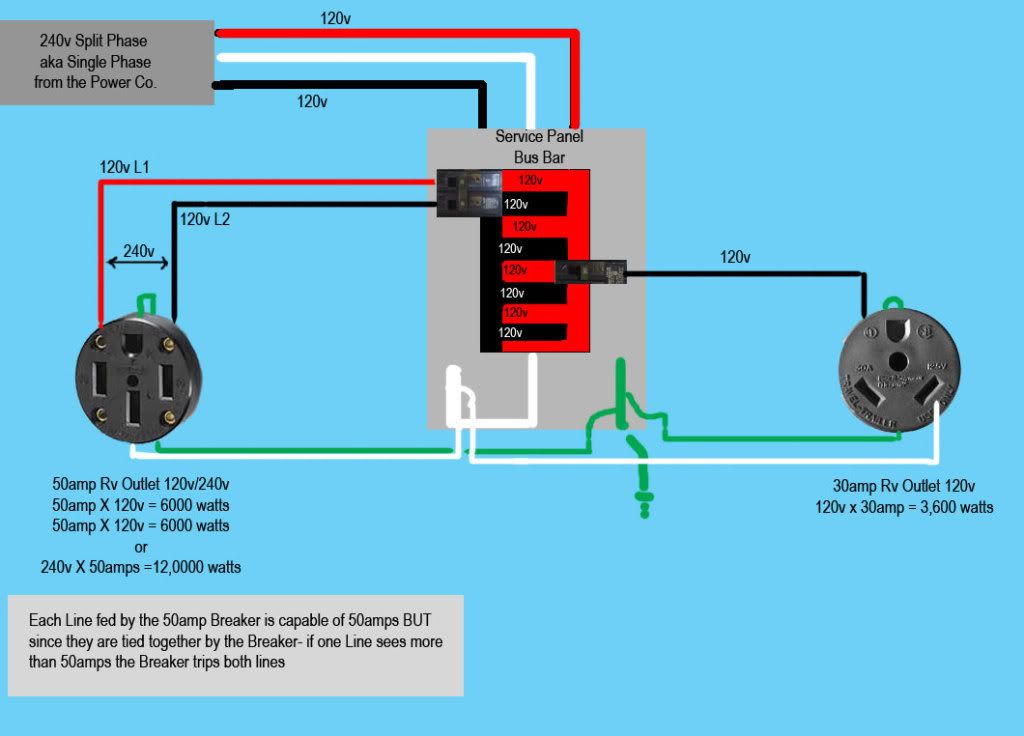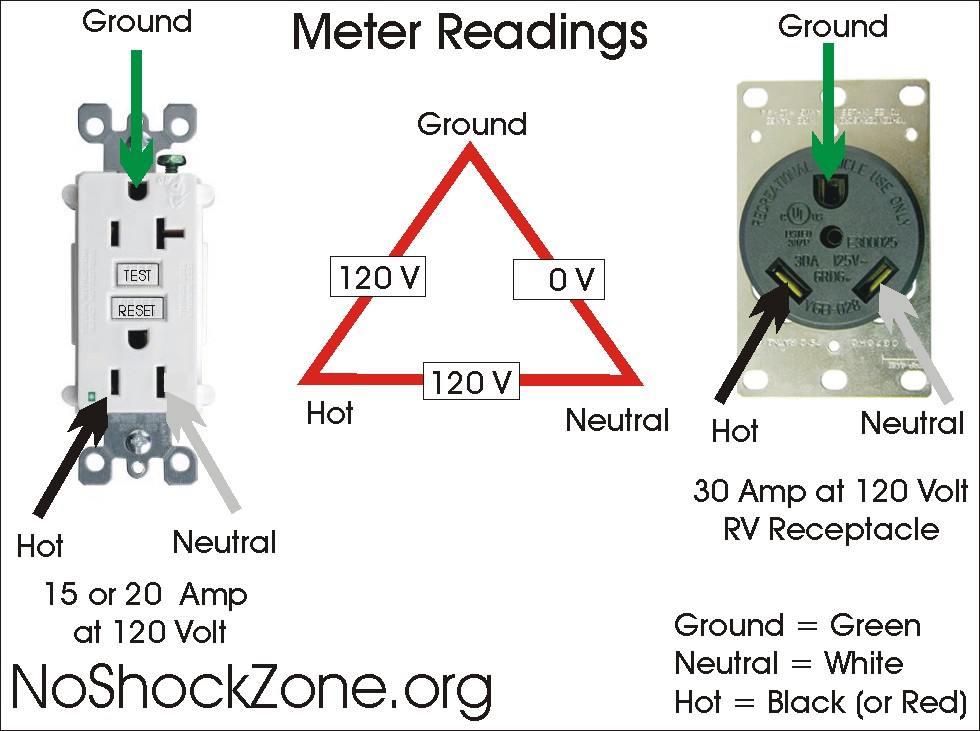Forum Discussion
46 Replies
- RoyBExplorer III forgot to add this pictorial to the above post... This shows how a typical CAMPGROUND RV PEDESTAL is wired up...

GOOGLE IMAGE
It is best to use a licensed Bonded electrician to do this work for as when they wire it up wrong and blow up all of the connected 120VAC Appliances their bonded insurance will replace your burned up appliances.
When your father-in-law or supposedly electrical smart friend or your smart self wires then up wrong you all will not have the insurance to pay for the damage. It will all be on you.... Check around the posts for how much all of this usually cost to replace. Not a cheap experience - 'believe me' as some politicians says...
Roy Ken - sammytooExplorer
Hank MI wrote:
All I can say is WOW!
x2 - allen8106ExplorerAll 50 amp feeds are two legs of 110 volts. All campers are 110 volts. No such thing as a 240 volt camper.
- RoyBExplorer II50AMP RV SERVICE CONNECTION
NO SHOCK ZONE IMAGE
NOTE the 240VAC is available but not tapped into except for some very high end RV's usually only used for 240VAC Dryer sets...
30AMP/20AMP/15AMP RV SERVICE CONNECTION
NO SHOCK ZONE IMAGE
NOTE the 30AMP RV connection is usually the one most likely to burn up all of your 120VAC appliances as some unknowing folks will wire these up using two HOT connections as it resembles the house 240VAC Dryer wiring connections.
Roy Ken - Hank_MIExplorerAll I can say is WOW!
LISTEN, although the 2 hot legs of a 50 amp supply are 120v when measure to neutral or ground they MUST be 180* out of phase resulting in a 240v supply. If they aren't out of phase, meaning both hot legs are being supplied from the same source hot leg. You have a problem. No neutral canceling can occur at your breaker panel. That means the neutral line must be capable of carrying 100 amps and need to be twice as large as the hot legs. It would also not meet any electrical code anywhere except maybe in Bangladesh.
If you don't understand it, stay away from it and hire a qualified electrician. - RoadpilotExplorer
Old-Biscuit wrote:
CG power pedestals have 120V AC whether it is a 50A 4 prong receptacle, a 30A 3 prong receptacle or the 20/15A regular house outlet.
ALL 120V AC
For RV use:
50A has TWO 120V AC HOT lines, ONE neutral, One ground
30A has ONE 10V AC HOT line, One neutral, one ground
20/15A same as 30A --One HOT, One neutral, one ground
This "correction" of timetoroll is not accurate. See time timetoroll's explanation. - Hank_MIExplorer
garyemunson wrote:
Well, as someone who is electrically literate, I guess I'll have to pull out my meter next time I'm at a campground. I've always thought that a 50 Amp campground outlet is wired just like a home dryer outlet. The way 110/220 electricity works is that either hot side to neutral (which, although is tied to ground in the supply panel is NOT considered the same) yields 110 Volts while measuring across the two 'hot' terminals provides 220. The only difference is that with campers, the wiring does not allow for 220 Volt use, just two 110 volt circuit that divide the RV's load between the two 110 Volt feeds. If you look at the power lines into your house, you will see 2 'hot' leads, a neutral and a ground. The technical answer is that your hot leads are coming off each end of a center tapped transformer that provides 220 Volts across the two ends of the transformer wiring and either end to the center tap (which is neutral and also tied to ground) provides 110 Volts. To be properly wired, the outlet must have each hot terminal connected to opposite ends of the transformer wiring so to provide 220 across the two hot legs. Unless RV outlet posts have some odd circuit breaker mount, a 'twin' 220 Volt breaker will draw from the two different sides of the supply transformer.
You're pretty much correct. There are some RV's with 240v dryers. The power lines coming into your house typically have 2 hots and a ground, no neutral. A true 240v load does not require a neutral, just 2 hot leads. Within your house the neutral load of one side (one hot lead) will cancel out the neutral load of the other hot lead at your service panel assuming loads are equal. When there is an imbalance, more load on one hot leg, the neutral load is carried back to transformer via the ground line. - RoadpilotExplorer
Old-Biscuit wrote:
CG power pedestals have 120V AC whether it is a 50A 4 prong receptacle, a 30A 3 prong receptacle or the 20/15A regular house outlet.
ALL 120V AC
For RV use:
50A has TWO 120V AC HOT lines, ONE neutral, One ground
30A has ONE 10V AC HOT line, One neutral, one ground
20/15A same as 30A --One HOT, One neutral, one ground
Timetoroll has it right.
Those that continue to say the 50amp spigot is 120 vac only should stop. They are wrong. - Hank_MIExplorer
1971duster340 wrote:
240V or 220V should be banned in most RV power supply discussions...it's confusing. Just because the receptacle in the shore power pedestal looks like your dryer socket, the electricity accomplishes different supply once it enters the dryer vs. your RV.
Think of your RV supply as having 2 seperate 120V wires that supply different portions of the RV, front half and back half in simple terms. While most 50A breakers are tied, if you could switch only one off, half your RV would loose power, but a dryer would only get half the voltage necessary to operate...bad news!
Electricians have wired a 120V, 50A RV receptacle incorrectly because it looks like that other, larger voltage supply they are familiar with...again, bad news.
Forgot to mention, the cable is fatter because it has 4 #8-#10 wires vs. 3 #10-#12 wires.
I think you're confusing the 30 amp 120v cord with the 50 amp 240v one. It's the 30 amp cord that looks like the old 3 wire 240v dryer plug. Electricians have wired the supply for 240v, 2 hots, ground and no neutral. That will destroy a 30 amp rv since it's expecting 30 amp 120v, 1 hot, 1 neutral and 1 ground. The 50 amp supply is a 240v supply, not 120v as you said.
The fact that the 2 hots of a 50 amp connection feed different circuits in the RV is no different than what happens in your house. If you have a gas clothes dryer and stove it's likely the only 240v load would be central AC unit. Everything else is 120v running off one of the 2 hot legs. 240v is not confusing, it's better that people understand the differences between a 30 and 50 amp supply than to assume they're all the same. That's when problems happen. - garyemunsonExplorer IIWell, as someone who is electrically literate, I guess I'll have to pull out my meter next time I'm at a campground. I've always thought that a 50 Amp campground outlet is wired just like a home dryer outlet. The way 110/220 electricity works is that either hot side to neutral (which, although is tied to ground in the supply panel is NOT considered the same) yields 110 Volts while measuring across the two 'hot' terminals provides 220. The only difference is that with campers, the wiring does not allow for 220 Volt use, just two 110 volt circuit that divide the RV's load between the two 110 Volt feeds. If you look at the power lines into your house, you will see 2 'hot' leads, a neutral and a ground. The technical answer is that your hot leads are coming off each end of a center tapped transformer that provides 220 Volts across the two ends of the transformer wiring and either end to the center tap (which is neutral and also tied to ground) provides 110 Volts. To be properly wired, the outlet must have each hot terminal connected to opposite ends of the transformer wiring so to provide 220 across the two hot legs. Unless RV outlet posts have some odd circuit breaker mount, a 'twin' 220 Volt breaker will draw from the two different sides of the supply transformer.
About RV Newbies
4,031 PostsLatest Activity: Jul 31, 2025